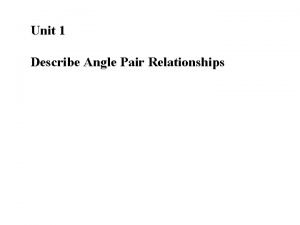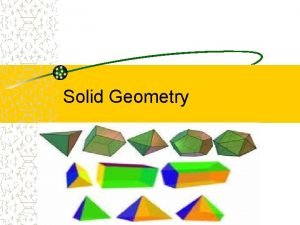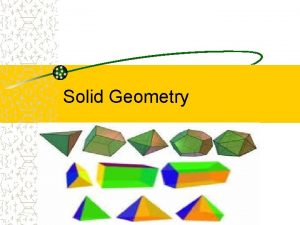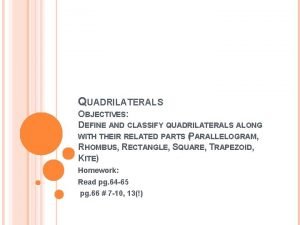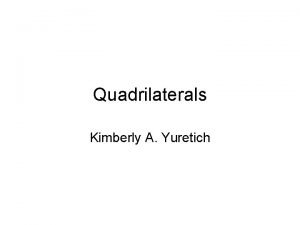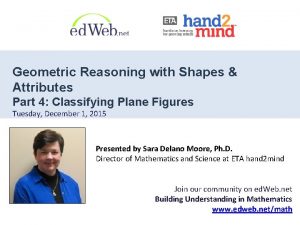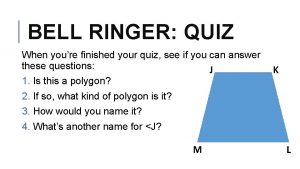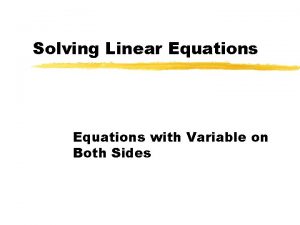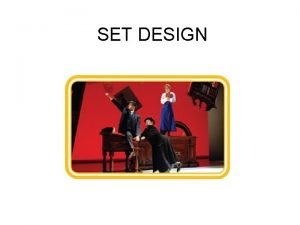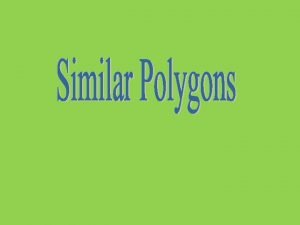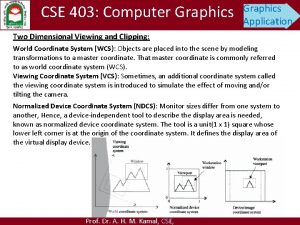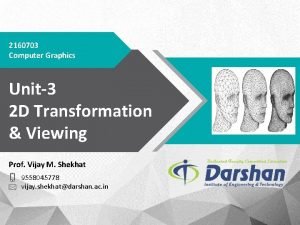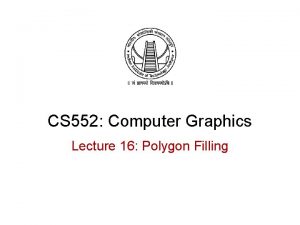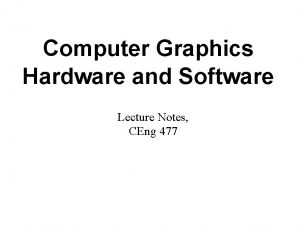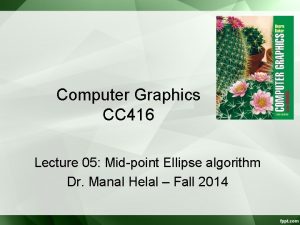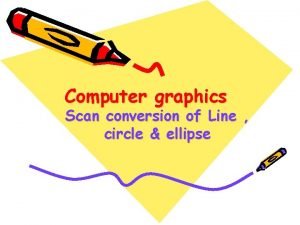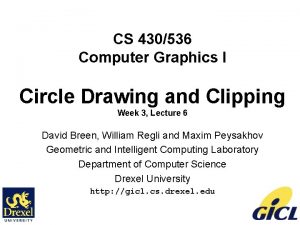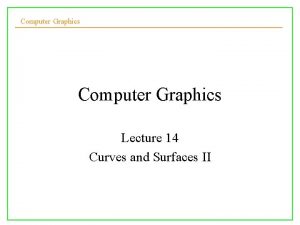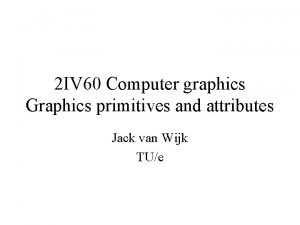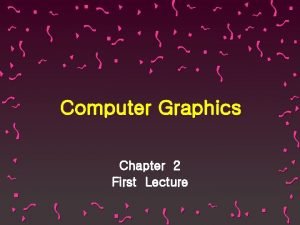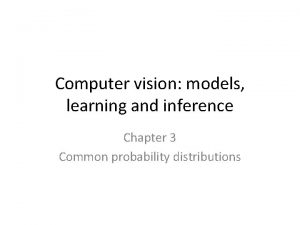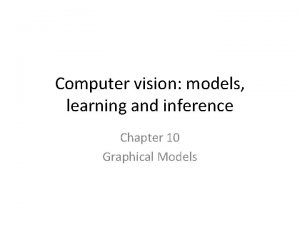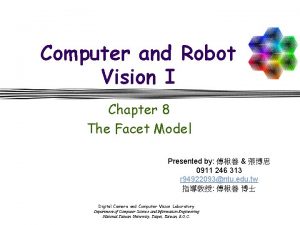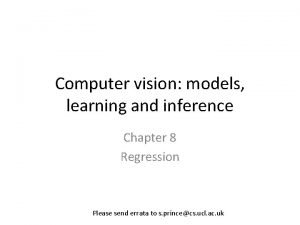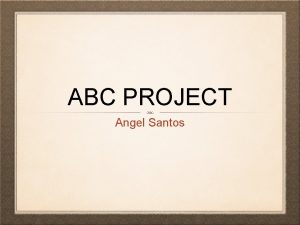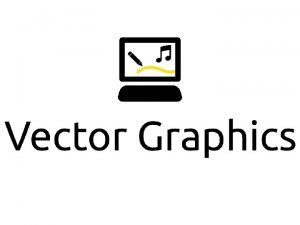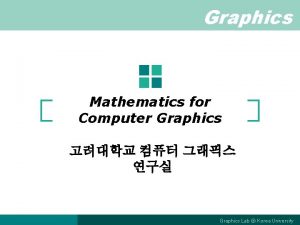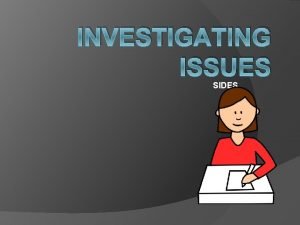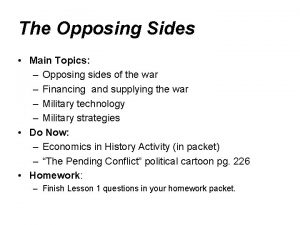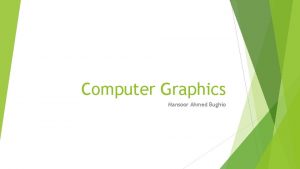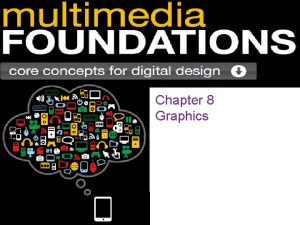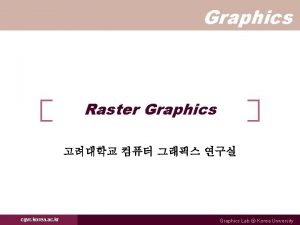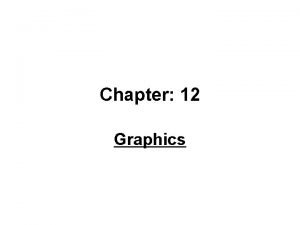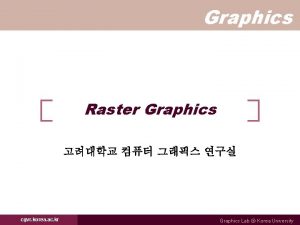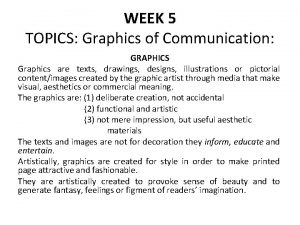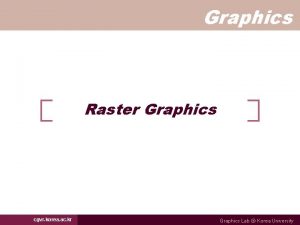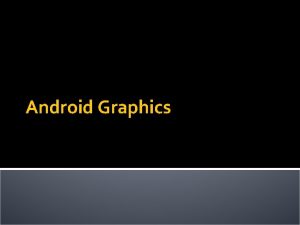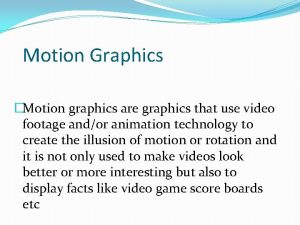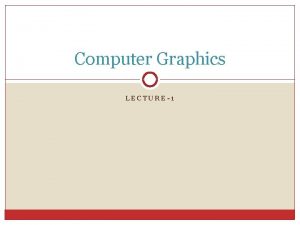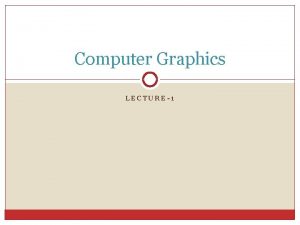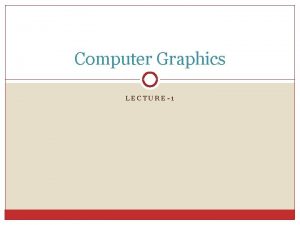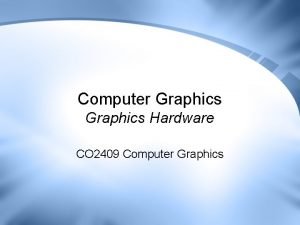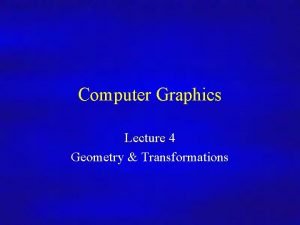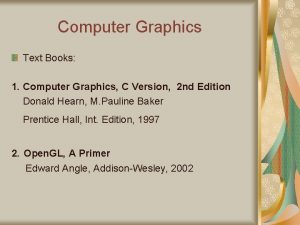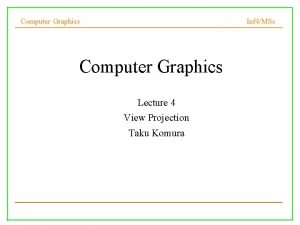Computer Vision and Computer Graphics Two sides of












![Math needed in the design of algorithms Example: Image Morphing [Beier & Neeley] Image Math needed in the design of algorithms Example: Image Morphing [Beier & Neeley] Image](https://slidetodoc.com/presentation_image/f72f7b030bdf1059fe8ab83b26b3b9b4/image-13.jpg)


![A very simple edge detection idea A[i, j] <- 5 A[i, j] - A[i+1, A very simple edge detection idea A[i, j] <- 5 A[i, j] - A[i+1,](https://slidetodoc.com/presentation_image/f72f7b030bdf1059fe8ab83b26b3b9b4/image-16.jpg)




























- Slides: 44

Computer Vision and Computer Graphics: Two sides of a coin COS 116: Apr 22, 2008 Sanjeev Arora

Brief history of image-making Camera obscura. Known to chinese; 5 th century BC 19 th century: Replace hole with lens; sketchpaper with light-sensitive paper. “Camera” Late 20 th century: Replace light-sensitive paper with electronic light sensor: “Digital camera. ”

Theme 1: What is an image?

What is an image? n Rectangular (2 D) array of pixels Digital image Continuous image “Pixels”

“Pixel” is a sample; need not be square (Many choices for “rendering” the same information) (Remember music lecture:

RGB Color Model Colors are additive Plate II. 3 from Fv. DFH R 0. 0 1. 0 0. 5 1. 0 0. 5 G 0. 0 1. 0 0. 5 0. 3 B 0. 0 1. 0 0. 5 0. 0 0. 1 Color Black Red Green Blue Yellow Magenta Cyan White ? ?

Adjusting Brightness n Simply scale pixel components ¨ Must Original clamp to range (e. g. , 0 to 1) Brighter

Adjusting Contrast n Compute average luminance L for all pixels ¨ luminance n = 0. 30*r + 0. 59*g + 0. 11*b Scale deviation from L for each pixel ¨ Must clamp to range (e. g. , 0 to 1) L Original More Contrast

Scaling the image n Resample with fewer or more pixels (mathy theory…) Original 1/4 X resolution

Theme 2: Computer vision vs Computer Graphics (and why they get mathy) Computer Vision: Understanding the “content” of an image (usually by creating a “model” of the depicted scene) Computer graphics: Creating an image from scratch Using a computer model.

Math used to understand/create images 1) Coordinate geometry (turns geometry into algebra) 2) Laws of perspective

(Math needed. . ) Physics of light n Light Source Lighting parameters ¨ Light source emission ¨ Surface reflectance Surface N N eye
![Math needed in the design of algorithms Example Image Morphing Beier Neeley Image Math needed in the design of algorithms Example: Image Morphing [Beier & Neeley] Image](https://slidetodoc.com/presentation_image/f72f7b030bdf1059fe8ab83b26b3b9b4/image-13.jpg)
Math needed in the design of algorithms Example: Image Morphing [Beier & Neeley] Image 0 Warp 0 Result Image 1 Warp 1

Intro to computer vision. What is depicted in this image?

Edge detection What is an “edge”? Place where image “changes” suddenly. How to identify edges?
![A very simple edge detection idea Ai j 5 Ai j Ai1 A very simple edge detection idea A[i, j] <- 5 A[i, j] - A[i+1,](https://slidetodoc.com/presentation_image/f72f7b030bdf1059fe8ab83b26b3b9b4/image-16.jpg)
A very simple edge detection idea A[i, j] <- 5 A[i, j] - A[i+1, j] - A[i-1, j] - A[i, j+1] -A[i, j-1] More sophisticated edge-detection uses smarter versions of this; use Gaussian filters, etc. Human eye does some version of edge detection. Edge info is still too “low level. ”

Image Segmentation What are the regions in this image? Uses many algorithmic ideas; still not 100% accurate

High level vision: Object recognition What do you see in this picture? Much harder task than it may seem. Tiger needs to be recognized from any angle, and under any lighting condition and background.

Aside At least 8 “levels” in human vision system. Object recognition seems to require transfer of information between levels, and the highest levels seem tied to rest of intelligence

Next: Computer Graphics Applications: n Entertainment n Computer-aided design n Scientific visualization n Training n Education n E-commerce n Computer art Inside a Thunderstorm (Bob Wilhelmson, UIUC) Boeing 777 Airplane

Step 1: Modeling n How to construct and represent shapes (in 3 D) (Remo 3 D)

Modeling in Sketch. Up (demo)

Example of “model”: wireframe n Most common: list of triangles ¨ Three vertices in 3 D (x 1, y 1, z 1) (x 2, y 2, z 2) (x 3, y 3, z 3) Usually would be augmented with info about texture, color etc.

Step 2: Rendering n Given a model, a source of light, and a point of view, how to render it on the screen?

Rendering (contd) n Direct illumination ¨ One bounce from light to eye ¨ Implemented in graphics cards ¨ Open. GL, Direct. X, … n Global illumination ¨ Many bounces ¨ Ray tracing Ray Tracing (Greg Larson) Direct Illumination (Chi Zhang, CS 426, Fall 99)

Ray Casting n n A (slow) method for computing direct illumination For each sample: ¨ Construct ray from eye through image plane ¨ Find first surface intersected by ray ¨ Compute color of sample based on surface properties eye

Simple Reflectance Model n Simple analytic model: ¨ diffuse reflection + ¨ specular reflection + ¨ ambient lighting Based on model proposed by Phong Surface

Diffuse Reflection n Assume surface reflects equally in all directions ¨ Examples: chalk, clay Surface

Specular Reflection n Reflection is strongest near mirror angle ¨ Examples: mirrors, metals N R q q L

Ambient Lighting n Represents reflection of all indirect illumination This is a total cheat (avoids complexity of global illumination)!

Path Types L = light D = diffuse bounce S = specular bounce E = eye

Path Types? Henrik Wann Jensen

Ray Tracing Henrik Wann Jensen

Ray Tracing Render. Park

Ray Tracing Terminator 2

Step 3: Animation n Keyframe animation ¨ Articulated n figures Simulation ¨ Particle systems Animation (Jon Beyer, CS 426, Spring 04) Simulation

Articulated Figures n Well-suited for humanoid characters Root Chest Neck Head LCollar LShld LHip RHip LKnee RKnee LAnkle RAnkle LElbow LWrist Rose et al. `96

Keyframe Animation: Luxo Jr. Pixar

Keyframe Animation Define character poses at specific times: “keyframes” n “In between” poses found by interpolation n Lasseter `87

Keyframe Animation n Inbetweening: may not be plausible Lasseter `87

Keyframe Animation n Solution: add more keyframes Lasseter `87

n But, animator cannot specify motion for: o Smoke, water, cloth, hair, fire o Soln: animation! Water Hot Gases (Foster & Metaxas `97) Cloth (Baraff & Witkin `98)

Particle Systems n A particle is a point mass v ¨ Mass ¨ Position ¨ Velocity ¨ Acceleration p = (x, y, z) ¨ Color ¨ Lifetime n Many particles to model complex phenomena ¨ Keep array of particles

Particle Systems n n Recall game of life, weather etc. … For each frame (time step): Create new particles and assign attributes ¨ Delete any expired particles ¨ Update particles based on attributes and physics Newton’s Law: f=ma ¨ Render particles ¨
 Computer graphics
Computer graphics Mathematical foundations of computer graphics and vision
Mathematical foundations of computer graphics and vision Graphics hardware in computer graphics ppt
Graphics hardware in computer graphics ppt Human vision vs computer vision
Human vision vs computer vision Are the indicated angles adjacent
Are the indicated angles adjacent A solid object with two identical ends and flat sides
A solid object with two identical ends and flat sides A solid object with two identical ends and flat sides
A solid object with two identical ends and flat sides Cold war
Cold war Advantage of proscenium stage
Advantage of proscenium stage No parallel sides
No parallel sides Two pairs of parallel sides
Two pairs of parallel sides Quadrilateral no parallel sides
Quadrilateral no parallel sides What are the two sides of fire service discipline?
What are the two sides of fire service discipline? Included angle example
Included angle example Shape that has 2 pairs of parallel sides
Shape that has 2 pairs of parallel sides Stage right stage left
Stage right stage left Solving linear equations variables on both sides
Solving linear equations variables on both sides Traverse stage
Traverse stage How to find if two polygons are similar
How to find if two polygons are similar Dear grandma and grandpa
Dear grandma and grandpa Two sides of ww1
Two sides of ww1 Interior and exterior clipping in computer graphics
Interior and exterior clipping in computer graphics Line drawing algorithms in computer graphics
Line drawing algorithms in computer graphics Points and lines in computer graphics ppt
Points and lines in computer graphics ppt In two dimensional viewing system have
In two dimensional viewing system have Shear transformation in computer graphics
Shear transformation in computer graphics Points and lines in computer graphics ppt
Points and lines in computer graphics ppt Flood fill algorithm in computer graphics
Flood fill algorithm in computer graphics What is computer
What is computer Ellipse parameters in computer graphics
Ellipse parameters in computer graphics Direct method line drawing algorithm
Direct method line drawing algorithm Pixel map in computer graphics
Pixel map in computer graphics Raster and random scan
Raster and random scan Circle and ellipse drawing algorithm in computer graphics
Circle and ellipse drawing algorithm in computer graphics Curves and surfaces for computer graphics
Curves and surfaces for computer graphics Aliasing and antialiasing in computer graphics
Aliasing and antialiasing in computer graphics Filled area primitives in computer graphics
Filled area primitives in computer graphics Two dimensional graphics
Two dimensional graphics Computer vision: models, learning, and inference
Computer vision: models, learning, and inference Computer vision: models, learning, and inference
Computer vision: models, learning, and inference Computer vision: models, learning, and inference pdf
Computer vision: models, learning, and inference pdf Computer and robot vision
Computer and robot vision Computer vision: models, learning, and inference
Computer vision: models, learning, and inference Angel computer graphics
Angel computer graphics Define projection in computer graphics
Define projection in computer graphics




